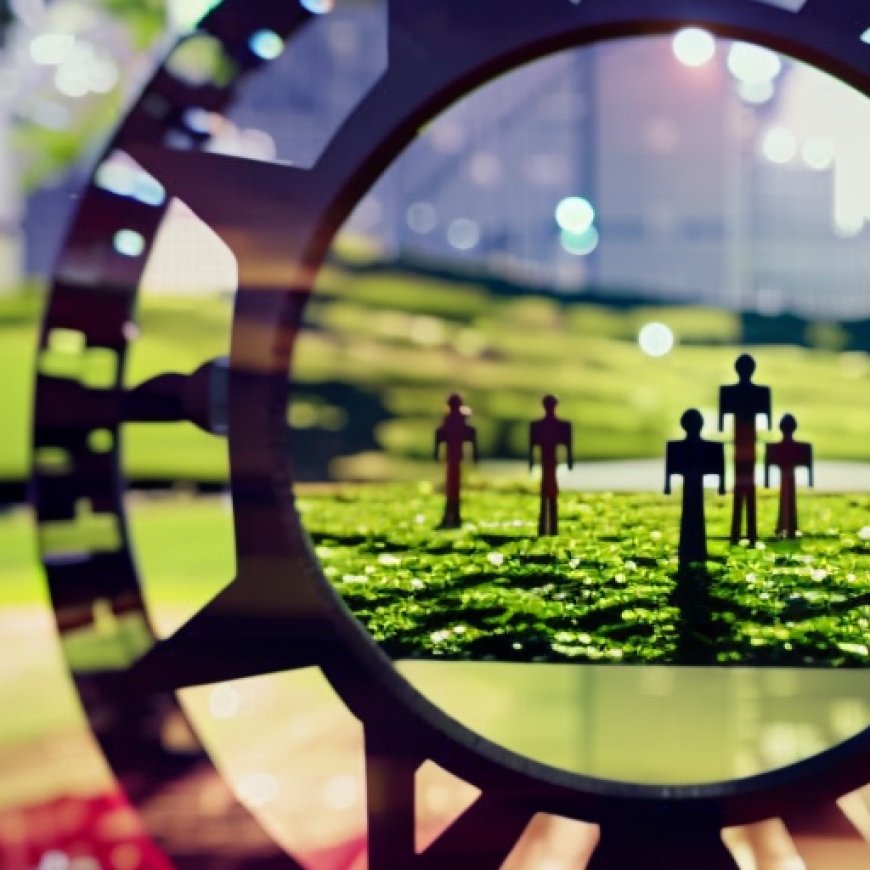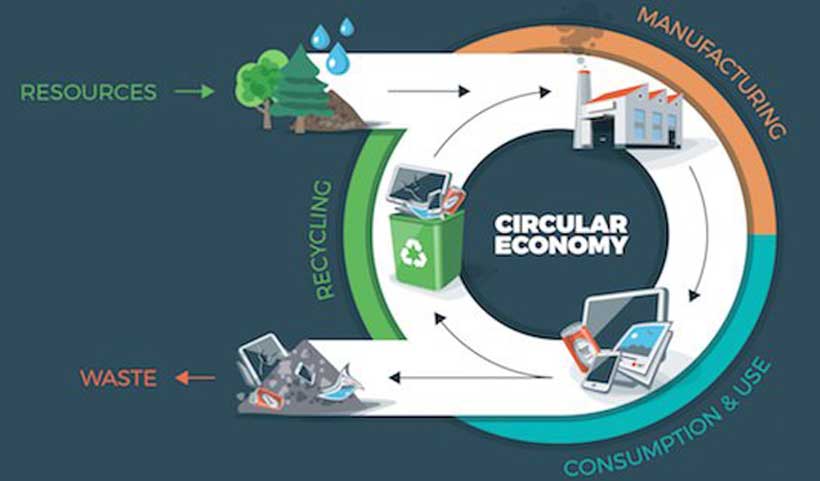Effectiveness of Circular Economy in ASEAN: Transition Strategies Adoptable by Indonesia – Modern Diplomacy
Effectiveness of Circular Economy in ASEAN: Transition Strategies Adoptable by Indonesia Modern Diplomacy


ASEAN’s Transition to a Circular Economy

ASEAN recognizes the need for a new economic approach to achieve long-term economic resilience amidst global challenges like climate change and resource depletion. This approach focuses not only on traditional economic processes of extraction, production, consumption, and disposal but also emphasizes more efficient resource utilization. Hence, the circular economy model becomes crucial, as it aims to restore, regenerate, and effectively utilize materials and energy.
The Concept of Circular Economy
The circular economy is an economic system designed to promote economic growth while preserving the value of products, materials, and resources within the economy for as long as possible, minimizing social and environmental damage caused by the linear economic approach (take-make-waste) (MacArthur, 2015). To support the implementation of the circular economy, ASEAN needs to create an ecosystem conducive to circular products and services. This includes prioritizing:
- Standard harmonization and mutual recognition agreements for circular products and services
- Trade openness and circular trade facilitation
- Technology utilization in greening supply chains (Innovation, Digitization, Green Technology)
- Access to sustainable and environmentally friendly project financing
- Efficient use of energy and other resources (ASEAN, 2021)
Successful Implementation in ASEAN Member Countries
ASEAN has committed to transitioning to a circular economy, supported by various national-level initiatives in several ASEAN member countries. Let’s take a look at some of these countries:
Indonesia
Indonesia has set targets to reduce marine waste by 70% by 2025 and to decrease greenhouse gas emissions by 29% by 2030 (Switch Asia, n.d.). Indonesia has also issued various policies to support the implementation of the circular economy, including Presidential Regulation No. 97 of 2017 concerning the National Policy and Strategy for Household Waste Management and Similar Household Waste (KEMENHUB, 2019).
Singapore
Singapore has set a master plan target to become a zero-waste nation by 2030. Singapore has implemented the circular economy through various initiatives, including the development of comprehensive recycling programs for construction waste, food waste, packaging waste, and electronic waste (Teo, 2020).
Malaysia
Malaysia has set a target to reduce waste sent to landfills by 30% by 2025. Malaysia implements the circular economy with various initiatives, including the implementation of a paid plastic bag policy since 2017, which has successfully reduced the use of single-use plastic bags. Malaysia also has a comprehensive recycling program, with the recycling rate reaching 28.1% in 2019 and predicted to reach 40% by 2025 (MIDA, 2021).
Thailand
Thailand has set a target to reduce waste sent to landfills by 50% by 2030. The Thai government has issued various policies and efforts to support the implementation of the circular economy. Thailand has a comprehensive food donation program, which helps reduce food waste. Thailand also promotes food waste reduction through various initiatives, such as community awareness campaigns and educational programs. Additionally, Thailand is developing technology for recycling agricultural waste, such as plant and animal waste. Thailand has successfully reduced the amount of food waste by 30% since 2018.
Vietnam
Vietnam has set a target to reduce waste sent to landfills by 50% by 2030. Vietnam has successfully implemented the circular economy through various initiatives, including community awareness campaigns to increase public awareness and understanding of the circular economy. The country has a comprehensive plastic recycling program, which helps reduce the amount of plastic waste in the ocean. Vietnam is also developing technology for recycling agricultural waste, such as plant and animal waste. Vietnam has successfully reduced the amount of plastic waste in the ocean by 20% since 2019.
Benefits and Challenges
These ASEAN countries have successfully reduced the amount of waste sent to landfills, plastic waste, and food waste. The circular economy can enhance resource efficiency, thereby reducing production costs and increasing competitiveness. It can create new jobs in recycling, repair, and sustainable design. The circular economy can also help protect the environment by reducing greenhouse gas emissions, pollution, and waste. Furthermore, it can improve the quality of life for communities. By implementing appropriate strategies, ASEAN countries can realize an effective and sustainable circular economy.
However, Indonesia faces challenges, as it still has limited infrastructure to support the implementation of the circular economy. Indonesia needs to enhance recycling infrastructure capacity, efficient waste collection systems, and waste processing and treatment centers. Indonesia still requires research and technology development to support the implementation of the circular economy, such as plastic and agricultural waste recycling technologies. Additionally, Indonesia needs to increase public awareness and understanding of the circular economy. Indonesia needs to conduct campaigns and education to raise awareness and understanding of the circular economy. To overcome these challenges and achieve its targets in the transition to a circular economy, Indonesia needs to implement appropriate strategies that can be adopted from the steps taken by ASEAN countries that have proven to be successful in implementing the concept of the circular economy at the national level.
SDGs, Targets, and Indicators
SDG 12: Responsible Consumption and Production
– Target 12.2: By 2030, achieve the sustainable management and efficient use of natural resources.
– Indicator 12.2.1: Material footprint, material footprint per capita, and material footprint per GDP.
SDG 13: Climate Action
– Target 13.2: Integrate climate change measures into national policies, strategies, and planning.
– Indicator 13.2.1: Number of countries that have integrated mitigation, adaptation, impact reduction, and early warning into primary, secondary, and tertiary curricula.
SDG 14: Life Below Water
– Target 14.1: By 2025, prevent and significantly reduce marine pollution of all kinds.
– Indicator 14.1.1: Index of coastal eutrophication and floating plastic debris density.
SDG 15: Life on Land
– Target 15.1: By 2020, ensure the conservation, restoration, and sustainable use of terrestrial and inland freshwater ecosystems and their services.
– Indicator 15.1.2: Proportion of important sites for terrestrial and freshwater biodiversity that are covered by protected areas.
Table: SDGs, Targets, and Indicators
| SDGs | Targets | Indicators |
|---|---|---|
| SDG 12: Responsible Consumption and Production | Target 12.2: By 2030, achieve the sustainable management and efficient use of natural resources. | Indicator 12.2.1: Material footprint, material footprint per capita, and material footprint per GDP. |
| SDG 13: Climate Action | Target 13.2: Integrate climate change measures into national policies, strategies, and planning. | Indicator 13.2.1: Number of countries that have integrated mitigation, adaptation, impact reduction, and early warning into primary, secondary, and tertiary curricula. |
| SDG 14: Life Below Water | Target 14.1: By 2025, prevent and significantly reduce marine pollution of all kinds. | Indicator 14.1.1: Index of coastal eutrophication and floating plastic debris density. |
| SDG 15: Life on Land | Target 15.1: By 2020, ensure the conservation, restoration, and sustainable use of terrestrial and inland freshwater ecosystems and their services. | Indicator 15.1.2: Proportion of important sites for terrestrial and freshwater biodiversity that are covered by protected areas. |
Analysis
1. Which SDGs are addressed or connected to the issues highlighted in the article?
The SDGs addressed or connected to the issues highlighted in the article are SDG 12 (Responsible Consumption and Production), SDG 13 (Climate Action), SDG 14 (Life Below Water), and SDG 15 (Life on Land).
2. What specific targets under those SDGs can be identified based on the article’s content?
– Under SDG 12, the specific target is to achieve the sustainable management and efficient use of natural resources (Target 12.2).
– Under SDG 13, the specific target is to integrate climate change measures into national policies, strategies, and planning (Target 13.2).
– Under SDG 14, the specific target is to prevent and significantly reduce marine pollution of all kinds by 2025 (Target 14.1).
– Under SDG 15, the specific target is to ensure the conservation, restoration, and sustainable use of terrestrial and inland freshwater ecosystems and their services by 2020 (Target 15.1).
3. Are there any indicators mentioned or implied in the article that can be used to measure progress towards the identified targets?
Yes, there are indicators mentioned or implied in the article that can be used to measure progress towards the identified targets:
– Indicator 12.2.1: Material footprint, material footprint per capita, and material footprint per GDP can measure progress towards achieving the sustainable management and efficient use of natural resources (Target 12.2).
– Indicator 13.2.1: Number of countries that have integrated mitigation, adaptation, impact reduction, and early warning into primary, secondary, and tertiary curricula can measure progress towards integrating climate change measures into national policies, strategies, and planning (Target 13.2).
– Indicator 14.1.1: Index of coastal eutrophication and floating plastic debris density can measure progress towards preventing and significantly reducing marine pollution of all kinds (Target 14.1).
– Indicator 15.1.2: Proportion of important sites for terrestrial and freshwater biodiversity that are covered by protected areas can measure progress towards ensuring the conservation, restoration, and sustainable use of terrestrial and inland freshwater ecosystems and their services (Target 15.1).
Overall, the article highlights the importance of the circular economy in achieving sustainable development goals and provides examples of ASEAN countries implementing circular economy initiatives to address issues related to responsible consumption and production, climate action, marine pollution, and terrestrial ecosystem conservation.
Behold! This splendid article springs forth from the wellspring of knowledge, shaped by a wondrous proprietary AI technology that delved into a vast ocean of data, illuminating the path towards the Sustainable Development Goals. Remember that all rights are reserved by SDG Investors LLC, empowering us to champion progress together.
Source: moderndiplomacy.eu

Join us, as fellow seekers of change, on a transformative journey at https://sdgtalks.ai/welcome, where you can become a member and actively contribute to shaping a brighter future.







